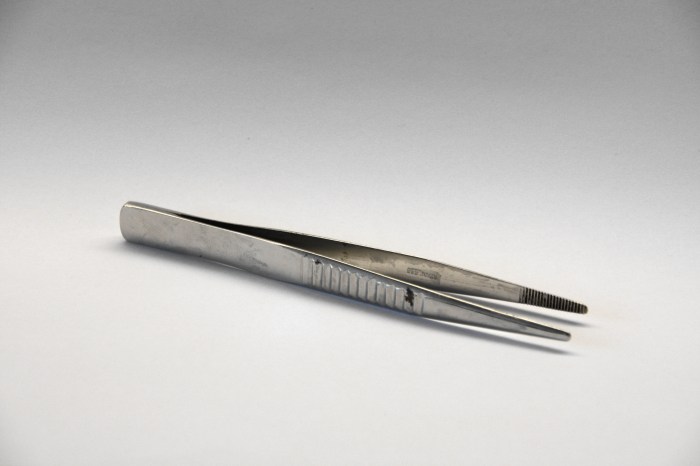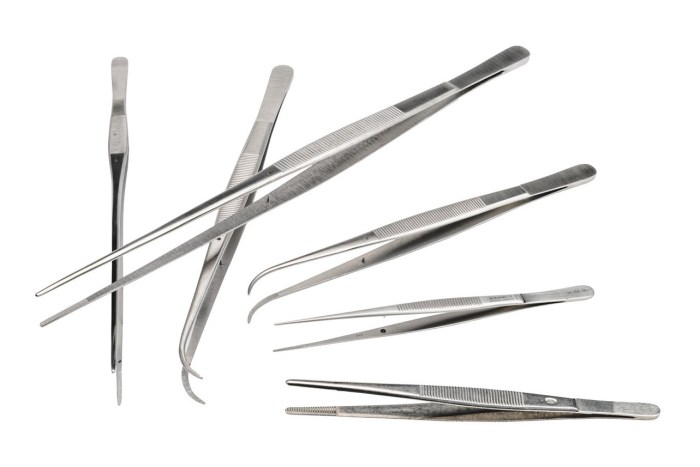Surgical instrument used to hold or grasp items – Surgical instruments used for holding or grasping items play a pivotal role in various surgical procedures, providing surgeons with the precision and control necessary to perform delicate and complex tasks. These instruments come in a wide array of designs, each tailored to specific surgical needs.
From delicate forceps to robust clamps, surgical grasping instruments are essential tools that enhance the safety, efficiency, and accuracy of surgical interventions. Their design and function have undergone continuous evolution, driven by technological advancements and the pursuit of improved patient outcomes.
Surgical Instruments Used for Holding or Grasping Items: Surgical Instrument Used To Hold Or Grasp Items

Surgical instruments used for holding or grasping items are essential tools in a wide range of surgical procedures. These instruments come in various types, each designed for a specific purpose. Understanding the different types, designs, and applications of these instruments is crucial for surgeons to perform procedures safely and efficiently.
Types of Surgical Instruments Used for Holding or Grasping
Surgical instruments used for holding or grasping items can be classified into several types based on their shape, size, and intended use. Common types include:
Forceps
Forceps are used for grasping and manipulating tissues, organs, and other objects during surgery. They come in various sizes and shapes, including straight, curved, and serrated forceps.
Clamps
Clamps are used to hold tissues together or to clamp blood vessels to prevent bleeding. They can be straight, curved, or angled, and may have jaws with teeth or serrations for better grip.
Retractors
Retractors are used to hold tissues apart and provide exposure to the surgical site. They come in various shapes and sizes, including handheld retractors, self-retaining retractors, and suction retractors.
Needle holders
Needle holders are used to hold and manipulate surgical needles during suturing. They have jaws that can be locked to secure the needle and prevent it from slipping.
Graspers
Graspers are used to hold and manipulate small objects, such as tissue samples or surgical sponges. They have delicate jaws that can be precisely controlled to avoid damaging delicate tissues.
Design and Function of Surgical Grasping Instruments
The design of surgical grasping instruments plays a critical role in their function. The shape, size, and materials used in the construction of these instruments affect their performance and ease of use.
Shape
The shape of the instrument determines its intended use. For example, forceps with curved jaws are used for grasping objects in difficult-to-reach areas, while straight forceps are used for more general purposes.
Size
The size of the instrument must be appropriate for the size of the object being grasped. Small instruments are used for delicate tissues, while larger instruments are used for larger objects or tissues.
Materials
Surgical grasping instruments are typically made of stainless steel or titanium. These materials are strong, durable, and resistant to corrosion. Some instruments may have coated jaws or tips to prevent damage to tissues.
Sterilization and Maintenance of Surgical Grasping Instruments, Surgical instrument used to hold or grasp items
Proper sterilization and maintenance of surgical grasping instruments are essential to prevent infection and ensure optimal performance.
Sterilization
Surgical grasping instruments must be sterilized before each use to kill any microorganisms that may be present on the instrument. Common sterilization methods include steam sterilization, ethylene oxide gas sterilization, and chemical sterilization.
Maintenance
Surgical grasping instruments should be inspected regularly for damage or wear. Instruments with damaged jaws or tips should be discarded to prevent injury to patients. Instruments should be stored in a clean, dry place to prevent corrosion.
Applications of Surgical Grasping Instruments
Surgical grasping instruments are used in a wide range of surgical procedures, including:
General surgery
Grasping instruments are used to hold and manipulate tissues during general surgical procedures, such as appendectomy, hernia repair, and cholecystectomy.
Cardiovascular surgery
Grasping instruments are used to hold and manipulate blood vessels during cardiovascular procedures, such as heart bypass surgery and valve replacement.
Neurosurgery
Grasping instruments are used to hold and manipulate delicate tissues during neurosurgical procedures, such as brain tumor removal and spinal surgery.
Orthopedic surgery
Grasping instruments are used to hold and manipulate bones and tissues during orthopedic procedures, such as joint replacement and fracture repair.
Innovations in Surgical Grasping Instruments
Technological advancements have led to innovations in surgical grasping instruments, improving their safety, efficiency, and precision.
Robotic-assisted instruments
Robotic-assisted instruments provide surgeons with enhanced precision and control during surgery. These instruments can be used to grasp and manipulate tissues in difficult-to-reach areas.
Minimally invasive instruments
Minimally invasive instruments are designed to reduce the size of surgical incisions. These instruments are often used in laparoscopic and robotic-assisted procedures.
Smart instruments
Smart instruments incorporate sensors and other technologies to provide surgeons with real-time information during surgery. These instruments can monitor tissue tension, blood flow, and other parameters to help surgeons make informed decisions.
Commonly Asked Questions
What are the different types of surgical grasping instruments?
Surgical grasping instruments come in a variety of types, including forceps, clamps, hemostats, and retractors, each designed for specific purposes and surgical procedures.
How are surgical grasping instruments sterilized?
Surgical grasping instruments are typically sterilized using methods such as autoclaving, ethylene oxide gas sterilization, or chemical sterilization to ensure they are free of microorganisms and safe for use in surgical procedures.
What is the importance of ergonomics in the design of surgical grasping instruments?
Ergonomics plays a crucial role in the design of surgical grasping instruments to reduce fatigue and discomfort for surgeons during prolonged use. Instruments are designed with comfortable handles, proper weight distribution, and appropriate grip sizes to enhance precision and minimize strain.


